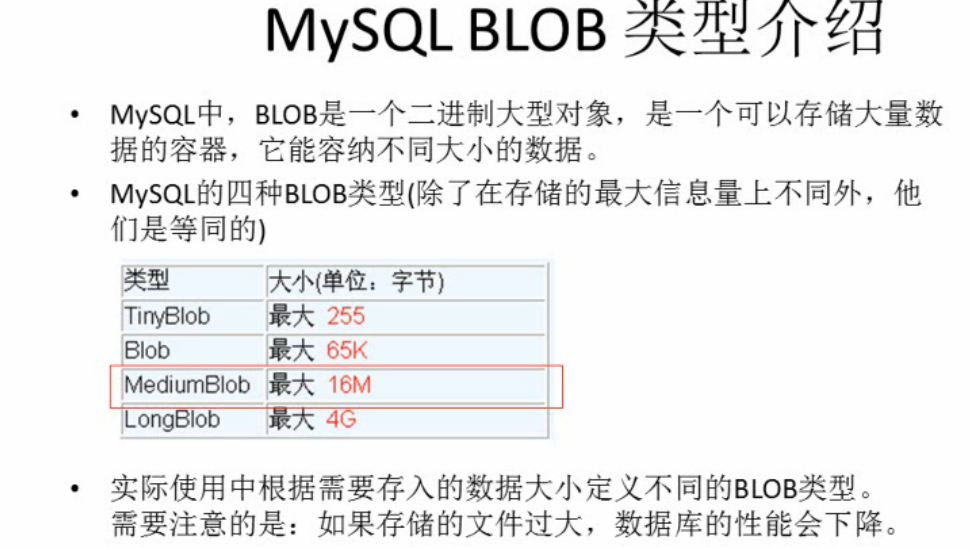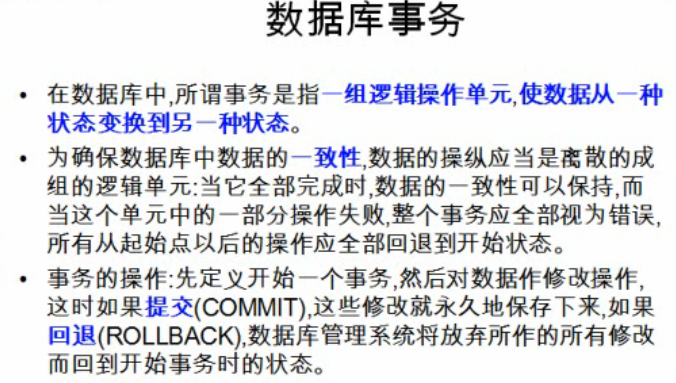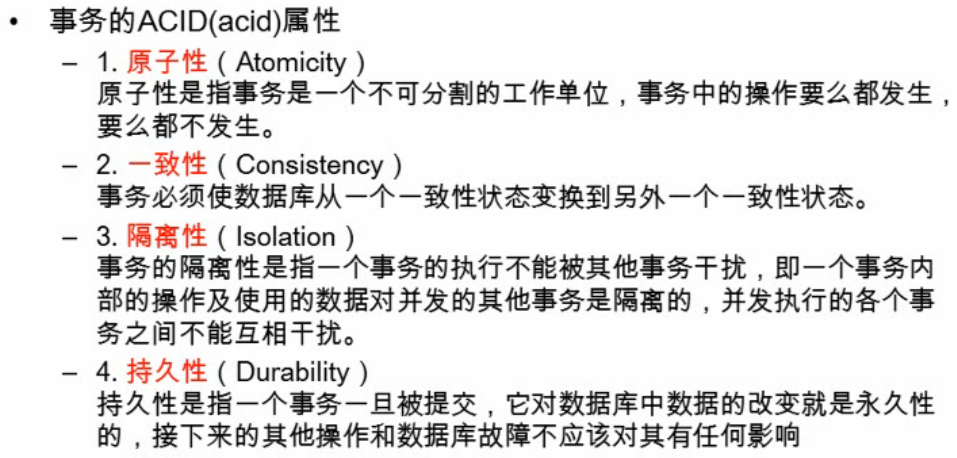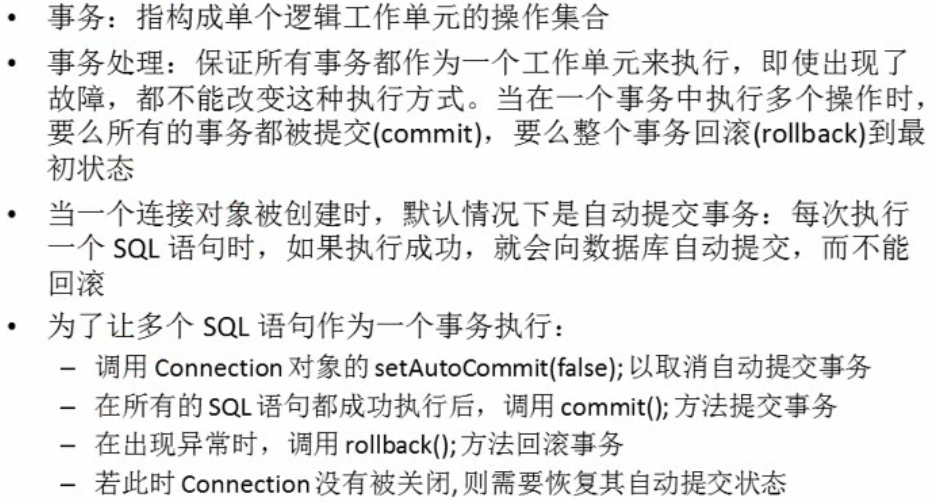【孤立的技术是没有价值的】,我们这里只是为了了解具体的实现步骤:我们在插入数据的时候,经常会需要获取我们插入的这一行数据对应的主键值。
具体的代码实现:
/**
* 获取数据库自动生成的主键
*/
@Test
public void testGetKeyValues(){
Connection connection=null;
PreparedStatement preparedStatement=null;
ResultSet rs=null;
try {
connection=JDBCTools.getConnection();
String sql="insert into customers(name,email,birth)"+
" values(?,?,?)";
// preparedStatement=connection.prepareStatement(sql);
//我们这里使用重载的prepareStatement(sql,flag)方法
//来生成prepareStatement对象
preparedStatement=connection.prepareStatement(sql, Statement.RETURN_GENERATED_KEYS);
preparedStatement.setString(1, "ABCDE");
preparedStatement.setString(2, "[email protected]");
preparedStatement.setDate(3, new Date(new java.util.Date().getTime()));
preparedStatement.executeUpdate();
//通过getGeneratedKeys方法获取包含了新生成的主键的ResultSet对象
//在ResultSet结果集中,只包含一列,列名:GENERATED_KEY,用于存放新生成的主键值
rs=preparedStatement.getGeneratedKeys();
if(rs.next()){
System.out.println(rs.getObject(1));
}
ResultSetMetaData rsmd=rs.getMetaData();
for(int i=0;i<rsmd.getColumnCount();i++){
System.out.println(rsmd.getColumnName(i+1));
}
} catch (Exception e) {
e.printStackTrace();
}finally{
JDBCTools.release(rs,preparedStatement,connection);
}
}处理Blob
Blob的基本概念


1).插入Blob类型数据
/**
* 插入Blob类型的数据必须使用PreparedStatement
* 因为Blob类型的数据是无法使用字符串拼写的
*
* 调用setBlob(int index,InputStream inputStream)
*/@Test
public void testInsertBlod(){
Connection connection=null;
PreparedStatement preparedStatement=null;
ResultSet rs=null;
try {
connection=JDBCTools.getConnection();
String sql="insert into customers(name,email,birth,picture)"+
" values(?,?,?,?)";
// preparedStatement=connection.prepareStatement(sql);
//我们这里使用重载的prepareStatement(sql,flag)方法
//来生成prepareStatement对象
preparedStatement=connection.prepareStatement(sql);
preparedStatement.setString(1, "ABCDE");
preparedStatement.setString(2, "[email protected]");
preparedStatement.setDate(3, new Date(new java.util.Date().getTime()));
InputStream inputStream=new FileInputStream("blob.png");
preparedStatement.setObject(4, inputStream);
preparedStatement.executeUpdate();
} catch (Exception e) {
e.printStackTrace();
}finally{
JDBCTools.release(rs,preparedStatement,connection);
}
}2).读取Blob类型数据
/**
* 读取Blob数据:
* 1.使用getBlob方法,读取Blod对象
* 2.调用Blob的getBinaryStream()方法得到输入流,再使用IO操作即可
*/@Test
public void testReadBlob(){
Connection connection = null;
PreparedStatement preparedStatement = null;
ResultSet resultSet = null;
try {
connection = JDBCTools.getConnection();
String sql = "select id,name,email,birth,picture"+
" from customers where id =18";
preparedStatement = connection.prepareStatement(sql);
resultSet = preparedStatement.executeQuery();
if (resultSet.next()) {
int id=resultSet.getInt(1);
String name=resultSet.getString(2);
String email=resultSet.getString(3);
System.out.println(id+":"+name+":"+email);
Blob pictureBlob=resultSet.getBlob(5);
InputStream inputStream=pictureBlob.getBinaryStream();
OutputStream out=new FileOutputStream("flo.png");
byte[] buffer=new byte[1024];
int len =0;
while((len=inputStream.read(buffer))!=-1){
out.write(buffer,0,len);
}
out.close();
inputStream.close();
}
} catch (Exception e) {
e.printStackTrace();
} finally {
JDBCTools.release(resultSet, preparedStatement, connection);
}
}数据库事务
数据库事务概述

数据库事务的四个属性

JDBC的数据库事务

我们做一个小实验:
先建立一个数据表:

试验中要用到的更新数据的通用方法update():要保证两次操作用一个connection连接,否则就不能被称为一次事务了。
public static void update(Connection connection,String sql,
Object ...args){
/**
* 执行SQL语句,使用PreparedStatement
*/
PreparedStatement preparedStatement=null;
try {
preparedStatement=connection.prepareStatement(sql);
for(int i=0;i<args.length;i++){
preparedStatement.setObject(i+1, args[i]);
}
preparedStatement.executeUpdate();
} catch (Exception e) {
e.printStackTrace();
}finally{
JDBCTools.release(null, preparedStatement, null);
}我们要完成的是:Tom->Jerry汇款500元
* 数据库事务
* 关于事务:
* 1.如果多个操作,每个操作使用的是自己的单独的连接,则无法保证事务
* 2.具体步骤:
* 1).开始事务,取消默认自动提交行为
* 2).如果事务的操作都成功,则提交事务:connection.commit();
* 3).回滚事务:若出现异常,则在catch块中回滚事务
我们组织代码就按照上面的步骤来进行.
public void testTeansaction() throws Exception{
Connection connection=null;
try {
connection=JDBCTools.getConnection();
System.out.println(connection.getAutoCommit());
String sql="update users set balance=balance-500 where id=1";
//开始事务:取消默认提交
connection.setAutoCommit(false);
update(connection,sql);
int i=10/0;
System.out.println(i);
sql="update users set balance=balance+500 where id=2";
JDBCTools.update(sql);
//提交事务
connection.commit();
} catch (Exception e) {
e.printStackTrace();
//回滚事务
try {
connection.rollback();
} catch (SQLException e1) {
e1.printStackTrace();
}
}finally{
//关闭连接
JDBCTools.release(null, null, connection);
}
}可以发现,因为我们使用的是同一个connection连接,当异常(除数为0)发生的时候,事务会发生回滚,数据库的数据会恢复到事务开始之前的状态.